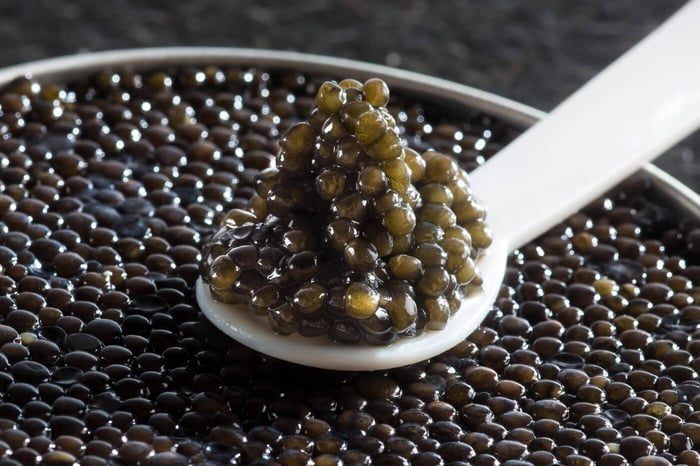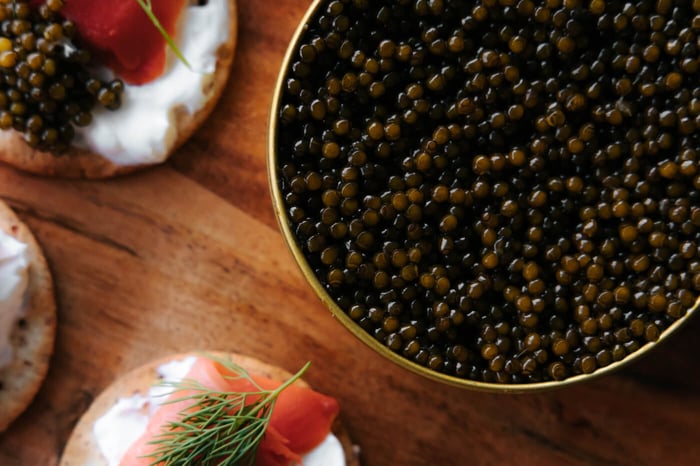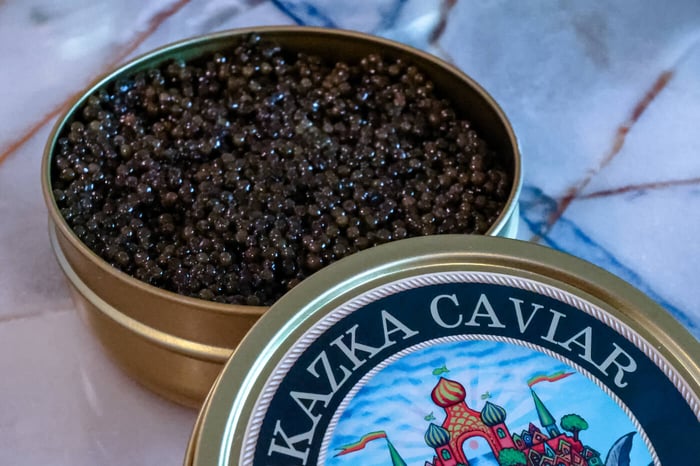What is Japanese Caviar?
When describing Caviar in Japanese culture, one has to explain how deeply such a product is rooted into the language of this nation. But first, let's establish the meaning of two simple terms: "caviar" always means product of the sturgeon fish family - black beads with deep taste; "roe" means all other types of fish eggs, such as salmon roe.
The word for salmon roe in Japanese is "ikura" (いくら), and by the way, the same Russian word is "ikra" - there must have been some historic relation in the past! So when ordering your next sushi, know that "Tamago ikura" literally means "(sushi) with egg and salmon roe".
Interestingly enough, the word "ikura" in Japanese also means "How much?" and in such a way it is widely used in modern Japan. "Ikura desu ka?" - you can often hear the expression in Japanese markets when people are asking how much does a certain item cost. So basically in Japanese terms, the value of salmon roe is equivalent to measuring how pricey something is. And it tells you something about their culture.
Read: Difference Between Caviar And Roe? Explained By An Expert

Aside from technicalities however, true caviar is far superior in taste then roe from any other fish largely because osetra fish mature time can be really long, which positively contributes to the overall flavor. On the other hand, certain types of low-priced roe can be obtained rather quickly without having a good chance of incorporating all those precious marine flavors.
A whole other story though is the highest grade wild-caught salmon raw obtained directly from fishermen being thereafter cooled down in order to remain fresh. If you're looking for such a high-end product, Skazka's selection of roe won’t disappoint.
History of Japanese Caviar
It all started in 1983 when a group of fish farmers from Kobayashi city in Miyazaki prefecture of Japan started collaboration with Soviet experts in order to lay the foundation of the Japanese caviar industry. The team chose Kobayashi city to arrange their fish farm because it has some of the cleanest water in the world, which is perfect for conditioning such an extravagant fish population, and Miyazaki Prefectural Fisheries Research Institute was also located there employing lots of skillful marine experts.
From Russian colleagues the farm received Beluga and Sterlad species for hybrid production and experiments started right away. It is known that hybrids - which are offsprings of two pure fish species, possess strong qualities from both of those species. Thus, their survival rate, maturation times, and proneness to illnesses are strongly improved.

How is Japanese Caviar produced?
Nowadays sturgeon fish farms can be found all over Japan. And those are mainly aimed at caviar production - sturgeon fish itself is a delicacy that, unlike in many other parts of the world, never took off in this country.
Although Japan has a rather warm climate, cold water from mountain rivers used on the farms helps simulate natural sturgeon biomes. Also, there are other aspects in sturgeon growth that need to be thoroughly controlled such as quality of feed, fish health, and monitoring for the best conditions for caviar extraction.
Japanese are not only closing the distance compared to other fish farms in the world in terms of quality caviar production, but they are also innovating, much like they did so with electronics back in the 70s. It so happens that it takes a lot of man-hours in order to determine sex of a relatively small population of young sturgeon in order to separate male from female species (and further grow caviar from females), but there is an alternative to manual labor.
Researchers from Kindai University suggested that the female population ratio could be significantly increased with the help of early hormone therapy. A year-long experiment showed that after feeding fish for six months with hormone estradiol, a certain part of the population contained female egg cells. This technology has been successfully in use since 1995 and only the future will tell if there is more that could be further improved.
Flavor Profile
Miyazaki Caviar, first and one of the most renowned manufacturers of Japanese caviar has set the highest standard right from the start. Their product is meticulously checked for any contaminants, metals, and even radiation before it gets frozen ready to be distributed. Talking about Japanese caviar cost - it's sold domestically for around $150 per ounce.
Miyazaki Caviar has a slightly sweet, creamy yet subtle taste, much like Skazkas’ Kaluga with salinity at around 3%, which is quite low (standard being 3-5%) - any less and salt won't serve its purpose and more than 5% salinity would simply kill the taste. It differs from caviar with a more pronounced nutty flavor and smaller egg size, like Siberian Sturgeon Caviar. Nicely paired with sake or other exquisite dishes, it's widely served in Michelin-star restaurants across Japan.

Japanese Caviar in Sushi
Undoubtedly one of the main reasons people love having dinner at a sushi restaurant is their sense of aesthetics. And roe from different kinds of fish - be that Tobiko, Masago, Uni or Salmon roe, is a perfect dish beautifier and taste booster. Thus the question arises - if roe is so widely used in the budget to middle segment, does Japanese caviar sushi have any chance to be a viable high-end option or is it something impractical and futile?
The thing is, once a small minority starts appreciating a certain product, it tends to become a widespread commodity. And the problem with caviar production is that contrary to the fish roe industry, it's not suitable for fast affordable scaling. It took Miyazaki Caviar enterprise 30 years to prepare and grow the fish population and they still sell all their produce months ahead and in large batches to partners who value their dedication. If it ever happens, it would take decades to meet the demand of communities and start supplying local sushi restaurants with affordable Japanese caviar.

In many ways Japan is a rather special and unique country. The roots of their traditional kitchen are tightly connected with Chinese culture and date back thousands of years. Despite four main islands being located in the middle of the ocean with hundreds of fish species around, Japan has never had rivers full of sturgeon or a chance of cultivating a true sturgeon population by itself. But all that changed recently when a small yet persistent group of fish farmers decided to make true caviar a part of Japanese culture. Only the future will tell how this industry develops, but we hope that more and more businessmen, scientists, and farmers dedicate their skillset to protecting, preserving, and cultivating this unique and fruitful species known as sturgeon.
About the Author
 Igor Fishbeyn - Caviar Purveyor
Igor Fishbeyn - Caviar Purveyor
Igor Fishbeyn is purveyor of fine sturgeon caviar and creator of the Skazka Caviar brand. He is an expert with decades of experience specializing in importing, wholesaling, and retailing the finest quality caviar in the world. Igor frequently writes about caviar news and various topics about the caviar industry. He lives in San Francisco with his wife and daughter.
Shop Skazka Caviar
Browse Our Exclusive Caviar Collection
“River Beluga” Kaluga Sturgeon Caviar
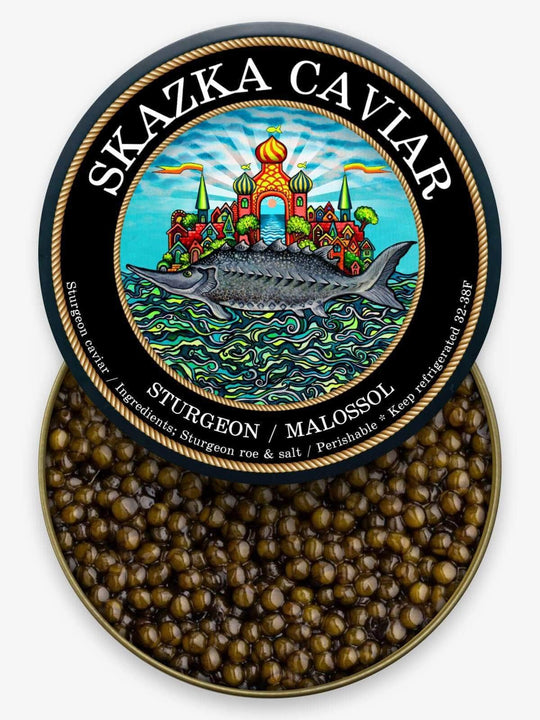
$295
$395
This large, robust caviar is a favorite of connoisseurs. Its firmness provides a satisfying texture that will keep you coming back for seconds and even thirds. Its luxurious chocolate brown color is perfectly evocative of its rich taste. Hints of… read more
“Oprah’s Favorite” Russian Osetra Caviar
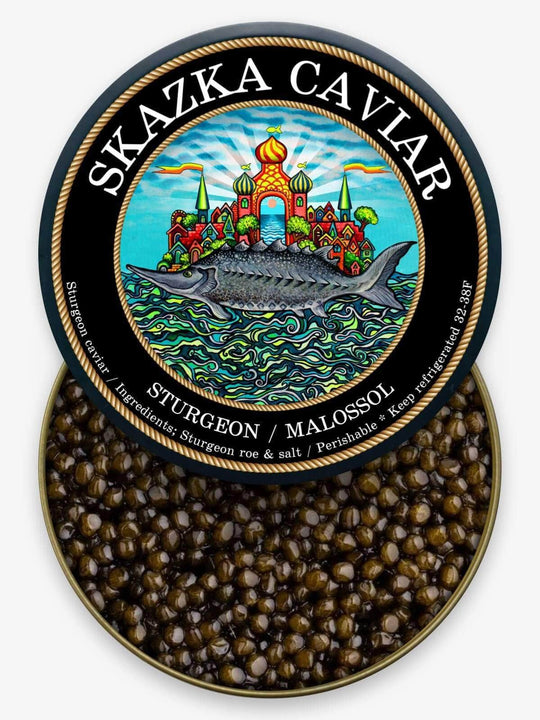
$295
$335
This medium-sized caviar is sure to be the star of any party or function you may throw. Its deep chocolate brown color is indicative of its rich and buttery flavor. Amber Osetra caviar has one of the cleanest tastes of any… read more
"Russian Czar" Beluga Sturgeon Caviar
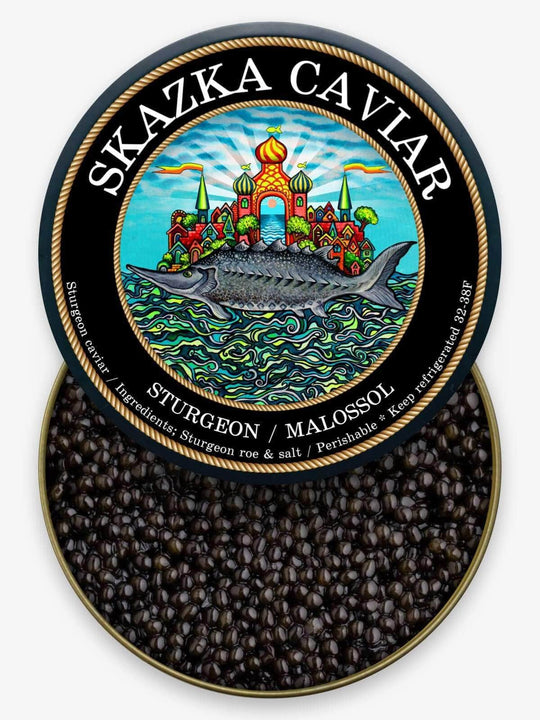
$495
$599
With an incomparable richness, “Russian Czar” Beluga Sturgeon Caviar is a knockout when it comes to fine caviar. Traditionally harvested in Russia, this caviar holds a tradition of greatness throughout history. With buttery notes that linger on the taste buds,… read more
Shop Caviar By Type
Shop Black Caviar | Shop Red Caviar | Shop Caviar Accessories
Shop Beluga Caviar | Shop Kaluga Caviar | Shop White Sturgeon Caviar
Shop Osetra Caviar | Shop Salmon Roe | Shop Albino Sturgeon Caviar


